Effect of Fennel Seed Supplementation into Broiler Diet on Their Growth, Physiological, and Immunological Performance
Effect of Fennel Seed Supplementation into Broiler Diet on Their Growth, Physiological, and Immunological Performance
Farid S. Nassar1,2, Osama A. El-Sayed3, Saidi Ouassaf4, Ahmed O. Abbas1,2*
Effect of dietary supplementation with different levels of fennel seed (FS) on the productive traits of broilers. Treatment groups: C, FS10, FS20, and FS30 indicate the supplementation of fennel seed at the rate of 0, 10, 20, and 30 g/kg of diet, respectively. Variables: IBW, initial body weight; FBW, final body weight; TFI, total feed intake; BWG, body weight gain; and FCR, feed conversion ratio. Bars express the means ± standard error of means (n = 10 replicate pens per treatment group). P-value of the linear (L) and quadratic (Q) effects of FS levels are indicated for each variable.
Effect of dietary supplementation with different levels of fennel seed (FS) on the slaughter traits of broilers. Treatment groups: C, FS10, FS20, and FS30 indicate the supplementation of fennel seed at the rate of 0, 10, 20, and 30 g/kg of diet, respectively. Variables of slaughter traits are determined as a percentage of the live body weight. Bars express the means ± standard error of means (n = 20 birds per treatment group). P-value of the linear (L) and quadratic (Q) effects of FS levels are indicated for each variable.
Effect of dietary supplementation with different levels of fennel seed (FS) on the internal organs of broilers. Treatment groups: C, FS10, FS20, and FS30 indicate the supplementation of fennel seed at the rate of 0, 10, 20, and 30 g/kg of diet, respectively. Variables of internal organs are determined as a percentage of the live body weight. Bars express the means ± standard error of means (n = 20 birds per treatment group). P-value of the linear (L) and quadratic (Q) effects of FS levels are indicated for each variable.
Effect of dietary supplementation with different levels of fennel seed (FS) on the plasma biochemicals of broilers. Treatment groups: C, FS10, FS20, and FS30 indicate the supplementation of fennel seed at the rate of 0, 10, 20, and 30 g/kg of diet, respectively. Variables: TP, total protein; T3, triiodothyronine hormone; ALT, alanine aminotransferase enzyme; AST, aspartate aminotransferase enzyme; and UA, uric acid. Bars express the means ± standard error of means (n = 20 samples per treatment group). P-value of the linear (L) and quadratic (Q) effects of FS levels are indicated for each variable.
Effect of dietary supplementation with different levels of fennel seed (FS) on the plasma cholesterols of broilers. Treatment groups: C, FS10, FS20, and FS30 indicate the supplementation of fennel seed at the rate of 0, 10, 20, and 30 g/kg of diet, respectively. Variables: TG, triglycerides; TCH, total cholesterol; LDL-CH, low-density lipoprotein cholesterol; and HDL-CH, high-density lipoprotein cholesterol. Bars express the means ± standard error of means (n = 20 samples per treatment group). P-value of the linear (L) and quadratic (Q) effects of FS levels are indicated for each variable
Effect of dietary supplementation with different levels of fennel seed (FS) on the stress indicators of broilers. Treatment groups: C, FS10, FS20, and FS30 indicate the supplementation of fennel seed at the rate of 0, 10, 20, and 30 g/kg of diet, respectively. Variables: CORT, corticosterone hormone; and MDA, malonedialdehyde. Bars express the means ± standard error of means (n = 20 samples per treatment group). P-value of the linear (L) and quadratic (Q) effects of FS levels are indicated for each variable.
Effect of dietary supplementation with different levels of fennel seed (FS) on the immune status of broilers. Treatment groups: C, FS10, FS20, and FS30 indicate the supplementation of fennel seed at the rate of 0, 10, 20, and 30 g/kg of diet, respectively. Variables: AB titer, antibody titer against sheep red blood cells; and PHA-WR, phytohemagglutinin-wattle reaction. Bars express the means ± standard error of means (n = 20 samples per treatment group). P-value of the linear (L) and quadratic (Q) effects of FS levels are indicated for each variable.













